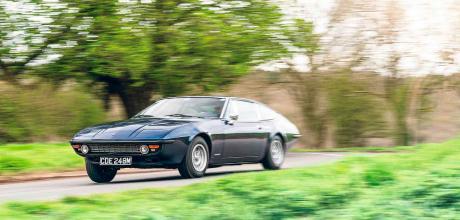Road test 1974 Bitter CD
For one entrepreneur, the lure of Italian beauty with American power was not enough: it needed German build quality, too. The result was the Bitter CD.
Words Glen Waddington
Photography Jordan Butters
DREAM INTO ACTION
Ultra-rare and super-stylish coachbuilt GT
There’s a fair bit of German logic about the Bitter CD. Plus a smattering of madness. It started life as a concept car and became reality thanks to the drive of a racer turned tuner. It’s stunningly styled, with involvement from a pukka Italian carrozzeria, and powered by a Corvette V8, yet it’s based on a large European executive saloon. And the plan was to build it in some quantity, though the result is now exceedingly rare: you’re looking at the only example in the UK.
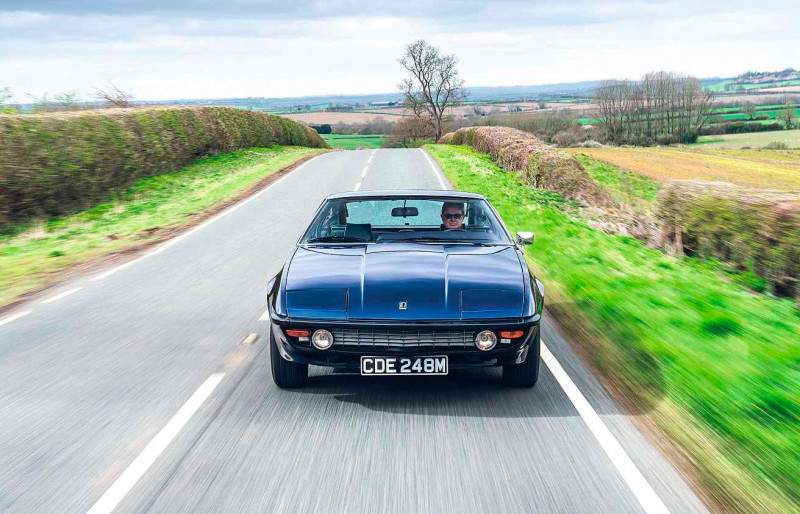
‘THE CORVETTE V8 BURBLES INTO LIFE AND YOU PULL AWAY WITH HASTE, WHILE IT GARGLES AWAY’
To understand the car, first you have to consider the man behind it. Erich Bitter is now approaching 90, but at the age of 20 he began a stint as a professional cyclist, having left school at 16 to work in his parents’ bike shop, not far from Düsseldorf. He became one of Germany’s top riders, competing in the Tour de France before he switched his attention to cars.
Bitter raced in the Targa Florio and at the Nürburgring, and drove for NSU (thanks to that cycling connection) and Abarth, among others. In 1968 he began a relationship with Opel, driving a 150bhp Rekord nicknamed Schwarze Witwe (‘Black Widow’), setting several class records and getting Bitter noticed among senior members of Opel management. Meanwhile, Bitter had opened a dealership, selling NSU, Saab and Volvo, and becoming the official German importer for Abarth and subsequently Intermeccanica. He also sold car accessories and tuning equipment under the Rallye Bitter brand, and was instrumental in the development of flameproof Nomex racesuits, after surviving the horror of a fire when he crashed his Abarth at the Nürburgring in 1969, never to race again.
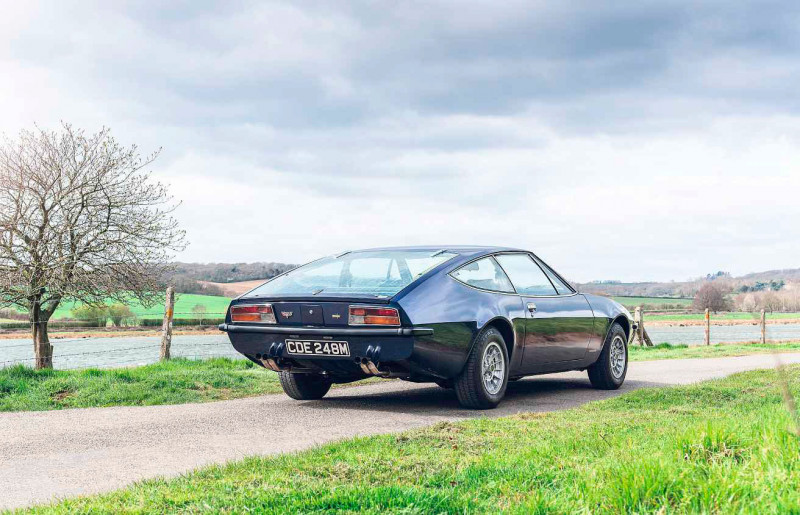
As Bitter turned his back on the track, further south in Rüsselsheim Opel was preparing to stun visitors to the Frankfurt motor show. With the American Bob Lutz at the helm of GM’s European outpost since 1963, and following the launch of the ‘junior Corvette’ Opel GT in 1968, the company’s stylists created a bold luxury coupé. Chief among them was Chuck Jordan, a man who made his name as Harley Earl’s protégé and rose to become Cadillac’s director of design, responsible for the 1959 Eldorado. At Opel he’d styled the GT, but the ‘Styling CD’ (for ‘Coupé Diplomat’, some suggest) was a full-on concept car, with flush glazing and radical proportions, built on a shortened version of the large, luxurious Opel Diplomat’s platform.
‘I KNEW AT FIRST SIGHT WHAT IT WAS; I ALSO KNEW I’D NEVER SEEN ONE BEFORE’
It wowed the crowds in 1969, and tingled enough scalps among Opel’s big-wigs that the company asked Italian design house Frua to prepare a version that could be built in volume, with conventional doors and glazing and on the same platform, to be powered by Chevrolet’s Corvette V8. That was in 1970. A year later Jordan moved back to the USA and was replaced as design chief by Dave Hollis, who regularly used the car, as did several other Opel executives. But when Frua proved to be unable to fulfil Lutz’s requirements for fullscale production, the project foundered.
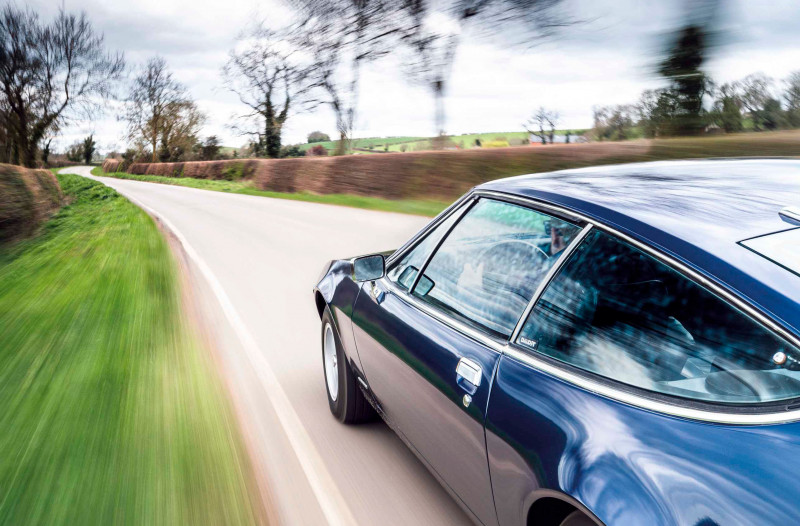
Nevertheless, Erich Bitter, a regular visitor to Russelsheim since his racing days, was impressed by what he’d seen. A beautiful GT with reliable V8 running gear, built to German standards of quality and reliability? It was looking like a more attractive prospect than the troublesome Intermeccanica Indra: a car with stunning Italian styling and powered by an American V8, but with warranty costs that were causing Bitter to rethink. He didn’t have the capital to set up his own production line but Opel was keen to see its new GT produced, even if that was under a different brand-name. As Bitter himself is reported as saying: ‘They had the right idea, the car was a beautiful design and sold for a top price. I believed that the potential was there for a car with handbuilt bodywork and mass-produced mechanical components.’ He reckoned Opel’s floorplan and running gear made a strong selling point, as there were few rivals that offered supercar aesthetics and interior opulence with everyday reliability. ‘I want a beautiful, fast car, but I also want to get in it and drive away,’ he stated.
‘BITTER DIDN’T HAVE THE CAPITAL TO SET UP HIS OWN PRODUCTION LINE BUT OPEL WAS KEEN TO SEE ITS NEW GT PRODUCED’
So Bitter set-up office in his home town of Schwelm and got in touch with the Stuttgartbased coachbuilder Baur. Baur was well-known for building prototypes for German manufacturers, as well as carrying out limited production runs. It quickly presented Bitter with a lifesize model of its proposal, which had evolved somewhat from Frua’s to look a little less classical, perhaps a little more like Chuck Jordan’s original vision, with some help from Opel’s Dave Hollis. The changes included different glazing – less obviously like the Maserati Ghibli’s – plus slimmer, black bumpers, and less brightwork overall.
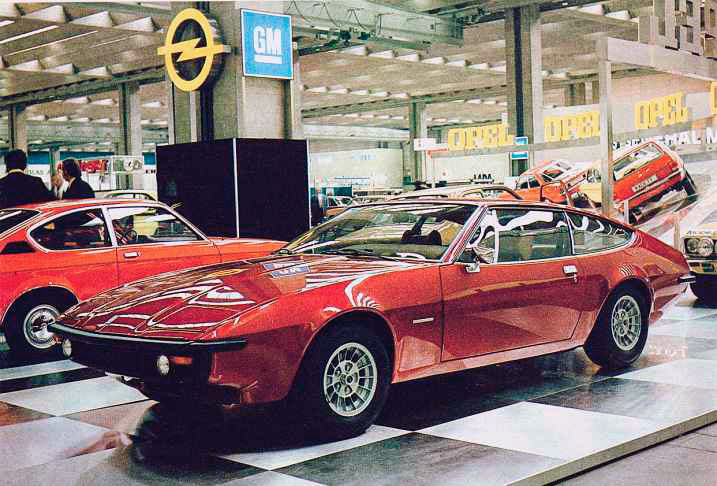
Baur would assemble the bodyshells, make and attach the panels, mate the running gear to the body and also trim the interior. Opel would provide the shortened Diplomat floorpan, as developed for its own Styling CD concept car and for the two Frua CD prototypes. Because the finished result would distribute its slightly greater weight differently than did the Diplomat, the coil spring settings were altered and specially tuned Bilstein dampers specified. Chevrolet’s 327ci V8 (fully 5.3 litres), as used in the Diplomat, was carried over unchanged. The CD was finally shown at Frankfurt in 1973, and the ecstatic Erich Bitter, who’d longed to be taken seriously as a car manufacturer, took orders for 176 cars, with plans to build 200 per year.
BICESTER HERITAGE’S Sunday Scramble can be petrolhead paradise. Sure, there are lots of interesting cars to be found within the event, but you can spend just as long scouring the classic car parking area. There are 911s galore, of course, plus plenty else from E-types to Hemi ’Cudas and pre-war Bentleys. And sometimes you’ll spot something you don’t often see. There, resplendent in dark blue, I spotted Andrew Grace’s Bitter CD. I knew at first sight what it was; I also knew I’d never seen one before.
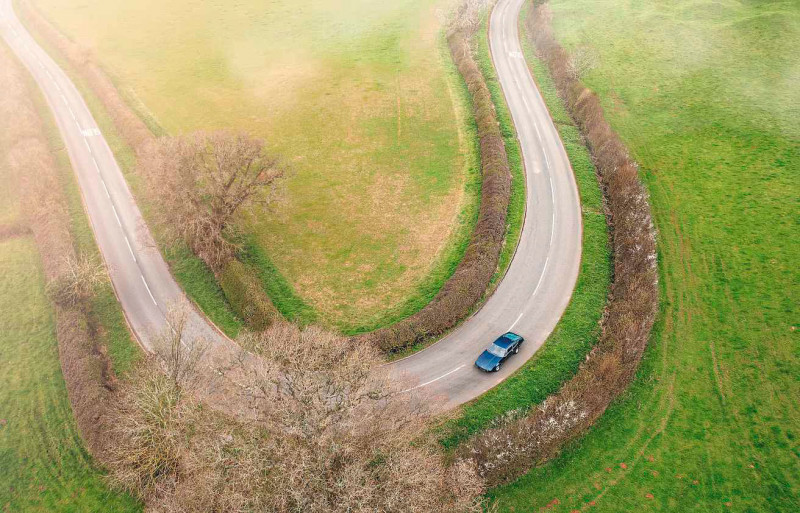
‘The car belonged to my dad, in South Africa, which is where I was born and brought up,’ says Andrew. It had been exported there new, and restored locally in 2000 during previous ownership by Dave Lyons, when the original Rochester carburettor was swapped for a four-barrel Holley. ‘Dad fell in love with the shape and sound of the car. At the time, Dave Lyons coveted dad’s immaculate 1927 Austin Seven delivery van. They did a deal in 2011, and dad acquired the Bitter. Although he loved it, its horrendous fuel consumption meant that he wasn’t using it much as he has several other classics. I loved the shape of the car from photos and, when visiting in early 2013, I found it even more gorgeous in the metal. We got talking and, in a moment of weakness, dad agreed to sell the car to me. Dad and Dave Lyons both admit they regret selling it.’ Andrew was working in Canada at the time, but arrived in the UK in 2014 – as did the Bitter. That same year, both attended the annual Bitter Club International event in the Netherlands. ‘I met Erich Bitter there, who remembered the car clearly and the whole story of its move to South Africa. There were 12 Bitter CDs in attendance. Mine was confirmed as the earliest example on their register, number ten. Erich’s advice to me was never to sell it.’
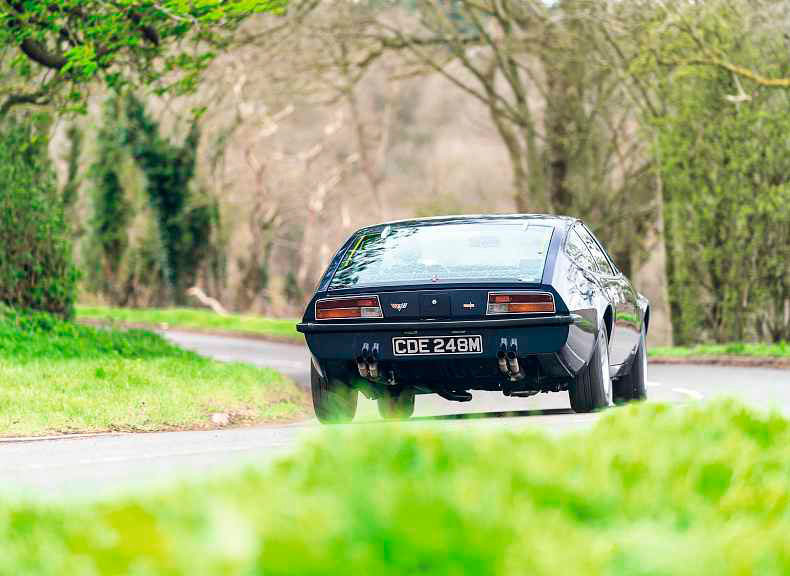
Why so rare? Well, as we know, 176 orders were taken at that Frankfurt debut, but, mere weeks into production, the oil crisis struck. The CD was priced at DM58,400, around £9000 – for context, that was about halfway between the price of a Dino 308 GT4 and that of a Ferrari 365 GT4 2+2 (a car we’ll come back to later) – but even those wealthy enough to place an order had second thoughts when it came to facing the running costs of a Detroit V8 in Europe. Only six Bitter CDs had been sold by the end of 1973.
Things improved the following year, and the car attracted European footballers and pop stars but, from a production high of 99 in 1974, output had become a mere trickle in the CD’s final year of 1979, with 37 sold to make for a grand total of 395. Something else was being prepared to take over by then, however.
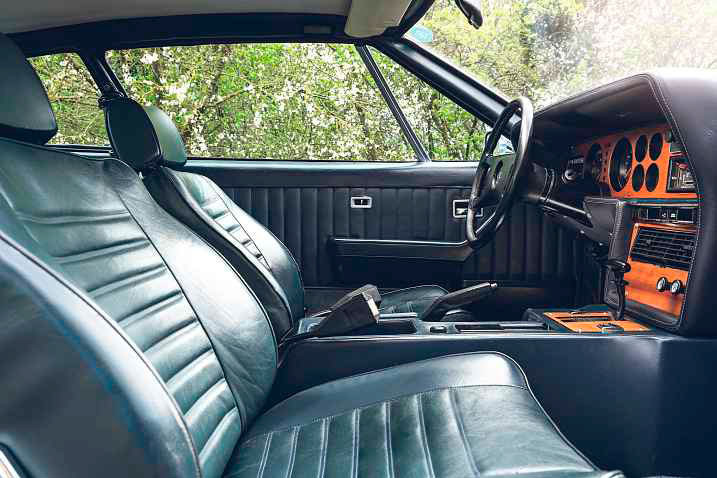
Before we come to that, it’s important to remember what a positive reception the CD received. The racing driver and journalist Paul Frère wrote about it for Road & Track in 1975, and called it ‘one of the best handling, most graceful and best finished cars ever marketed by General Motors’. He also suggested that its planned production figures made it ‘200 times more exclusive than a Corvette’, which turned out to be quite an understatement. Frère noted a ‘remarkable combination of good handling with excellent comfort’ but added that, while it was far quicker than any Rolls-Royce, the CD wouldn’t ‘take any customers away from Porsche and Ferrari’.
Maybe not, but for what is basically an Opel product (even one powered by the Corvette V8), to be mentioned in such highfalutin company is quite a statement in itself. It’s lengthy, low, sleek and sexy. Opening the driver’s door (it’s left-hand drive, of course, despite being a South African-market car) instantly reveals impressive structural integrity: for a door this long and heavy not to have dropped on its hinges after nearly 50 years is quite a feat.
You drop into a low-mounted and beautifully leather-trimmed armchair, facing a high and comprehensively fitted leather-wrapped, wood-faced dash. In here it positively pulsates with all those slightly louche ’70s GT vibes, and what little there is in the way of obvious parts-bin pilfering doesn’t lower the tone. OK, the transmission selector is the standard GM T-bar, and the hockey-stick doorpulls may well have come from the Opel Rekord of that time, but the individual VDO-badged instruments (and there are lots of them) not only wear their producer’s typeface (rather than something cheapened for the masses) but also carry little stuck-on Bitter logos.
Turn your head and the lounge-style rear seats certainly talk the talk, though it’s doubtful their occupants could walk the walk after sitting there for long, such is the angle of the CD’s stylish semi-frameless glass tailgate. The latter is one of its most distinctive assets; in other respects it recalls the Ferrari 365 GTC4 (see last issue), the Maserati Indy, and possibly even the rare-groove Monica 560, the Chrysler V8- powered four-door supercar developed by former Morgan racer Chris Lawrence that was very much a contemporary of the Bitter CD. The Corvette V8 burbles into life and idles quietly, rocking the car gently on its springs. Select Drive, and you pull away with haste, if less than supercar-style rocket thrust, while the V8 gargles away. I could go into cliché mode here about Rothmans-smoking 747 captains, blasting along a sun-kissed highway with an elbow on the door-top, Persols in place. It’s that kind of car.
Instead I’ll say that the steering, though light and low-geared, is sufficiently accurate that you can guide the CD through B-road bends with confidence, that the ride is buoyant, supple, and the suspension quiet in action, and that the whole thing gels if you’re prepared to hold the ratios yourself on the selector, flicking between first (good for nearly 60mph!) and second (good for rather more), using top only for that Persol/elbow thing.
Frère criticised the lack of a detent between first and second, while there was one between second and top, but mere humans on British roads will appreciate the ease with which you can shift between the lower two ratios in everyday driving yet feel protected from accidentally dropping a gear on the motorway. As for what came next, the V8 was no more, in its place Opel’s highly regarded cam-in-head straight-six. Introduced in 1981, the Bitter SC was the CD’s crisply styled replacement, on the ultra-competent, independently sprung Opel Senator platform (we Brits knew it initially as the Vauxhall Royale) because the Diplomat had run its course. It looked rather a lot like the aforementioned Ferrari 365 GT4 2+2, and it could be had with a stretched 3.9-litre version of the Commodore’s engine. It’s still a rarity, only 462 SC Coupés built, just 29 in right-hand drive, plus a one-off convertible show-car – and, following its launch in 1984, five of the four-door CD sedan version.
The sedan broke the company. Series production ended, though Bitter carried on with specials and some fancy retrims of bread-and-butter Opel saloons. But what a heyday. Ever imagined creating your own car company, and building a GT that one of the world’s most revered racers and motoring journalists would compare to Rolls-Royces and Ferraris? Erich Bitter lived that dream…
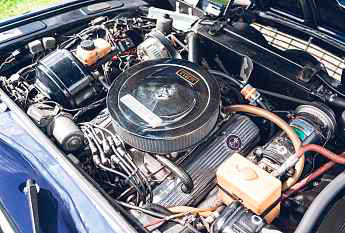
Above, left and opposite 5.3-litre V8 also powered the Corvette; leather-lined interior is laid-back in atmosphere and extremely comfortable; glass tailgate looks suitably exotic.
TECHNICAL DATA 1974 Bitter CD
- Engine 5354cc OHV V8, Rochester Quadrajet carburettor
- Max Power 218bhp @ 4700rpm
- Max Torque 315lb ft @ 3000-3200rpm
- Transmission Three-speed automatic, rear-wheel drive
- Steering Recirculating ball, power-assisted
- Suspension Front: unequal-length wishbones, coil springs, telescopic dampers, anti-roll bar. Rear: de Dion axle, trailing arms, coil springs,
- telescopic dampers, anti-roll bar
- Brakes Vented discs
- Weight 1755kg
- Top speed 130mph
- 0-60mph 9.4sec
Opposite and above Bitter launched the CD at the 1973 Frankfurt motor show; it’s long, low and sleek, every inch the transcontinental GT.


